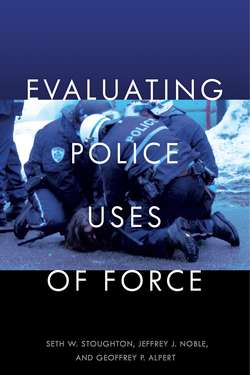Читать книгу Evaluating Police Uses of Force - Seth W. Stoughton - Страница 10
На сайте Литреса книга снята с продажи.
Part I Standards for Evaluating Police Uses of Force
ОглавлениеIn August 2014, an officer working for the municipal police department in the then-little-known St. Louis suburb of Ferguson, Missouri, shot and killed Michael Brown, an unarmed, black 18-year-old. The St. Louis County Prosecutor, Robert McCulloch, convened a grand jury to determine whether there was sufficient evidence to indict the officer. It was, by any measure, a complicated undertaking. The jurors met for months, heard hours of testimony from dozens of witnesses, and reviewed thousands of pages of documents. They also learned about how they should determine whether or not to indict the officer. The grand jury was first provided with a copy of a state statute that authorized the use of deadly force in certain circumstances, including to prevent the escape of a fleeing felon. Later, the grand jury was told about a Supreme Court case that held that officers can use deadly force only when they have probable cause to believe that the subject presents an imminent threat of death or great bodily harm.
What, then, should the grand jury have done if it concluded that, at the time of the shooting, Michael Brown was a fleeing felon, but did not present an imminent threat of death or great bodily harm? Applying the state statute, the officer’s actions were lawful, and an indictment would be unwarranted. Applying the Supreme Court case, the officer’s actions were unlawful, and an indictment would be entirely appropriate.
As that example demonstrates, the standard that is used to analyze a use of force is of tremendous practical importance. So which standard is the right one? Confusingly, there is no one “right” standard; it depends on context. More confusingly, there are at least four different standards that can be used to evaluate an officer’s use of force in the United States: the constitutional standard, the state law standard, the administrative standard, and the community expectations standard.
The first three standards—constitutional law, state law, and administrative regulations—each play a formal role in the evaluation of use-of-force incidents. When an officer’s use of force violates one or more of those standards, sanctions or remedies may be imposed. An officer who violates an administrative regulation, for example, can be disciplined or terminated by their agency, while a violation of the state or constitutional standards can result in civil liability or a criminal conviction.
For the other standard—community expectations—violations do not result in formal remedies. However, those standards remain important because violations can have significant, if informal, consequences: an officer, agency, or policing itself, as an institution, may be subject to public condemnation. In July 2017, for example, Minneapolis Police Chief Janeé Harteau resigned less than a week after Officer Mohamed Noor controversially shot Justine Ruszczyk, a woman who had called the police to report a potential assault near her home. Chief Harteau did not resign because the shooting was unconstitutional, illegal, or contrary to agency policy—at that early point, there had been no formal determination about any of those things. Instead, her resignation was driven in large part by the public pressure that resulted from the perception that the shooting had fallen far short of what community members expected. Despite its informality, community expectations may be the most potent of the various evaluative standards because, ultimately, they exert lasting influence on the other, more formal standards.
As that brief discussion suggests, the standards themselves are distinct, but they are all perfectly valid. They are not, however, perfectly interchangeable. The standards are context dependent. That is, the standard that we apply depends on the question that we are seeking to answer and the remedy that we may impose. Let us return to the grand jury in the Michael Brown shooting; should the prosecutors have instructed the jurors about the state standard or about the constitutional standard? The most obvious answer, one given by a number of legal scholars and other pundits at the time, is that the prosecutors should have instructed the jury about the constitutional standard. The Constitution sets the minimum level of protection, after all, so to the extent that state law purports to authorize the use of force in situations in which it would be constitutionally prohibited, it would appear that the state law was invalidated. That answer may be obvious, but it is also incorrect. The grand jury was called upon to determine whether there was probable cause to believe that, under state law, the officer’s actions were criminal. In that context, the constitutionality of the officer’s actions is irrelevant. It may be counterintuitive, but a state is not required to criminalize an unconstitutional use of force (nor, for that matter, is a state prohibited from criminalizing constitutional uses of force).
Understanding the evaluation of police uses of force, then, requires one to appreciate that any given use of force is subject to different evaluative standards. The first step in evaluating an incident is to identify which standard is being applied, what behavior that standard regulates, and how that standard regulates the use of force. The chapters in part I of this book provide a comprehensive look at those issues, with each one dedicated to a discussion of a particular standard. Chapter 1 provides a detailed roadmap of the constitutional standard that applies most frequently in federal court. Chapter 2 outlines the state law standard that applies to both civil and criminal claims. Chapter 3 explores the administrative standards that individual police agencies create through policy, procedure, and training. Chapter 4 is dedicated to a discussion of community expectations, which are less formal, but no less important for evaluating use-of-force incidents.
